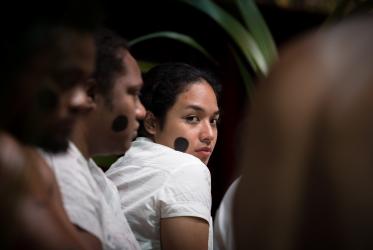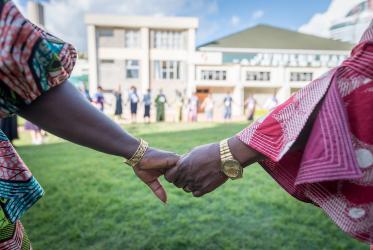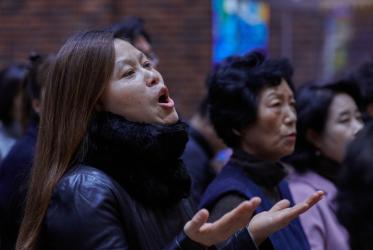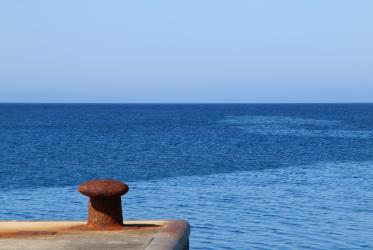Move through the lobby of the Ecumenical Centre in Geneva, and you will “walk” with some 90 faces, the people who tell, at least in part, the story of the World Council of Churches (WCC) over 70 years. On large panels, an exhibition of photos and phrases features people who have, in diverse ways, helped form the many facets of the WCC and the ecumenical movement.
From leadership of the Central Committee to presidents, to general secretaries, from youth to theological groundbreakers, the faces that make up the WCC’s history are from all parts of the globe, working through more than seven decades to face the challenges and share the accomplishments of the ecumenical movement.
At the center of the colorful panels that make up the exhibition? Prayer. “We place prayer at the centre of our identity as Christians and our pilgrimage of justice, peace and unity,” reads the text. Photographs of people are identified with names and the roles they played in WCC’s history.
Other headings on the panels include “Community of Women and Men,” “Mission and Evangelism,” “Service to the World,” “Struggle for Justice and Peace,” “Creation,” “Interfaith Dialogue,” and many more. Under the heading “Struggle for Justice and Peace,” the text reads: “We march together as a community upholding justice and we struggle for the true peace that comes with justice.”
Standing for a multitude
The exhibition, originally intended to be 70 faces representing the history of WCC, finally includes 90 faces, speaking to the difficulty of choosing among so many people who have been involved in the WCC. “As the photos fall on a path, they represent the past, present and future, and they intend to illustrate the wonderful ecumenical pilgrimage since 1948,” explained Georges (Yorgo) Lemopoulos, co-coordinator for the WCC 70th anniversary.
The 90 faces depicted on the panels stand for a multitude, added Lemopoulos. “The themes evoke a journey of creativity, newness, challenge and struggle on the way,” he said. “The whole reminds us of the tremendous legacy we have received but also the way ahead of us.”
It was difficult to encapsulate, even in the beautiful panels, the true treasure of the ecumenical movement, said Marcelo Schneider, communication officer. “Walk alongside the panels, and you will find people from across the WCC fellowship, from across the world, men and women, young and old, lay and ordained,” he said. “This is one portrayal of a highly unique fellowship that continue to evolve as we work, pray and walk together.”
The stories behind the faces
Behind each face depicted is a story of how people contribute to the ecumenical movement by touching the lives around them. A few examples:
Archbishop Anastasios of Tirana and All Albania, who served as a member of the WCC Central Committee (1998-2006) and as a president (2006-2013). A university professor, missiologist and missionary, he was known for his church and ecumenical leadership. He is the architect of the resurrection of the Orthodox Church of Albania. He has been walking on the ecumenical path since his youth, in the early 1960s.
Eugene Carson Blake, of the United Presbyterian Church, USA, served as general secretary of the WCC from 1966 - 72. He is remembered for his dual commitment to ecumenism and to social progress, especially in race relations. Early on, he manifested a keen interest in the ecumenical movement, and attended the first assembly of the WCC in 1948.
Carmencita Karagdag, from the Philippine Independent Church, served on the WCC Central Committee from 1968-2013. She continues to carry forward the ecumenical movement in the Philippines, where she works to promote environmental justice, advocate for ecological defenders, and work alongside indigenous leaders.
Bishop Federico J. Pagura, of the Evangelical Methodist Church of Argentina, served as a WCC president between 1998 - 2006. A pillar of Latin American and world ecumenism, he was a faithful and courageous champion of human rights and the cause of peace in Latin America and around the globe. He passed away in 2016.







